On April 12th, 1981, 20 years to the day from Yuri Gagarin’s history making Vostok 1 flight came the first flight of the Space Transportation System, more commonly known as the Space Shuttle. It was pure coincidence, as the Shuttle was originally scheduled to fly in 1979, but delay after delay, even up to the the original STS-1 launch day of April 10th, lead destiny to decide this same symbolic date as the inaugural flight day for Columbia, the first Space Shuttle.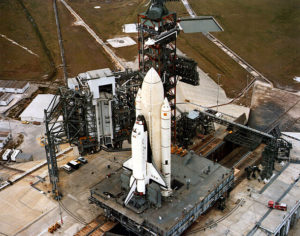
The Space Transportation System, as the Shuttle was officially named, was intended to cheapen the cost of getting cargo into space. By flying a reusable craft, known as the Orbiter, and re-using as many components as possible, while also packing as much payload as possible on each flight, economics of scale dictated that prices should drop 10 fold. Of course, we all know due to varying issues with the design of the Shuttle, this simply didn’t happen, but the program did capture the imagination of a new generation of people, like me, born after the Apollo program, and the golden days of the space race. The unique vehicle that the Shuttle was made it something else to watch fly, and even more amazing to think of it flying time and time again into space, carrying massive payloads into a low Earth orbit, docking with MIR, and later, helping build the International Space Station, something so massive I have clearly seen it from my own front yard.
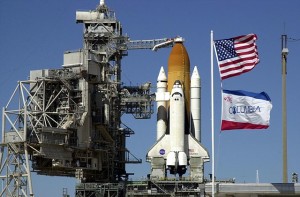
Of course, with the Challenger and Columbia disasters in 1986 and 2003, the Shuttle showed some of it’s ultimate weaknesses, and 14 lives were lost. Still, as flawed as it was, it seems the nation generally loved the Shuttle, even being saddened when the program was ended in 2011.
We’re getting ahead of ourselves, though. This isn’t a history of the Shuttle program, this is about that first flight of Columbia, of that first mission, of 4 that would prove that the Shuttle not only worked, but worked well. The components, the 3 Space Shuttle Main Engines, and the 2 Solid Rocket Boosters, had been tested as well as they could on the ground, but unlike every other launch system ever, the Shuttle had to fly with a crew. This meant everything had to work. This meant that for this first test flight, and every Shuttle flight, humans would be on board for a vehicle that, at this time, had never flown. It was all simulation, in wind tunnels, computers, and on paper. It all should work, but would it? There was only one way to tell – by launching Columbia.
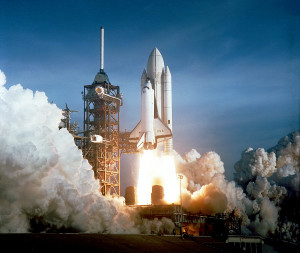
Columbia was not our first Shuttle Orbiter – that distinction goes to Enterprise. However, Enterprise was built originally for atmospheric glide tests, seeing if the air-frame would fly safely. It was intended to be converted into a space worthy vehicle, but those plans never came through, and regardless, Columbia was always planned to be the first space worth Orbiter. We knew it could land, but could it make it into space?
STS-1, the first Shuttle Mission was to be flown by John Young and Bob Crippen. John Young was a veteran of the Gemini era, and flew on Gemini 3 way back in 1965 with Gus Grissom. He would also walk on the Moon during Apollo 16 (an Apollo capsule I have actually seen with my own eyes, for what it’s worth). He would command this mission, with Bob Crippen, a rookie in space flights, acting as the pilot. It is safe to say that, for the Astronauts we had active in 1981, Columbia flew with the best of the best.
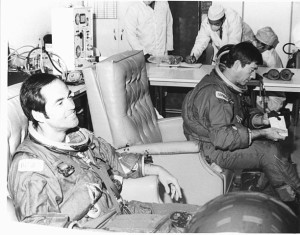
It was a 2 day mission, to simply test if the vehicle could actually fly. That morning, the crew donned their flight suits, and boarded the vehicle, it’s white painted external tank making this, and it’s follow up flight STS-2, unique compared to all other launches with their unpainted red-orange external fuel tanks. Also unique on this flight was the countdown. The Main Engines of the Orbiter ignited at T-3 seconds, rather than the usual T-6 seconds of later launches. It just creates an oddly unique feel to this first launch, when compared to later ones.
While the launch appeared fine, with the Shuttle flying “hot” (with more power than expected), things seemed good for the start of the program. However, once the Shuttle was in orbit and the payload bay doors were opened, the crew could see damage to the Thermal Protection System of the vehicle, The crew also noted that there was some damage they had seen during ascent, but they were surprised to see the missing tiles on the rear of the orbiter.
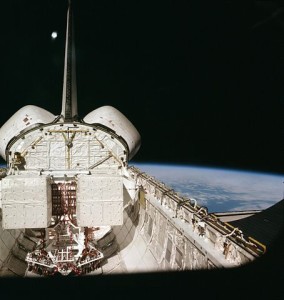
Not only that, but NASA had underestimated the power of the launch. Pressure waves from Solid Rocket Booster ignition had damaged the body flap of Columbia. Thankfully, this damage, while potentially catastrophic, wasn’t enough to keep the orbiter from its mission, or successfully landing 2 days later. The first Shuttle flight was a success, and for 23 more missions, everything seemed perfect, with flight after flight launching satellites, carrying scientific experiments, and allowing us to learn more about how space can help us here on Earth. This innocent period of the Space Shuttle program would end one cold morning in January of 1986, but for now, let us think back to what the Shuttle was to America, and what it was to be.
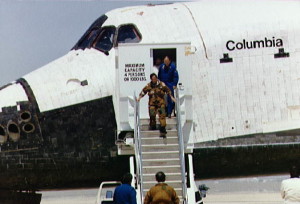
Of interest to this article, YouTube user LunarModule5 has uploaded the entire STS-1 flight. Enjoy it here:
https://en.wikipedia.org/wiki/STS-1
https://en.wikipedia.org/wiki/Space_Shuttle
https://en.wikipedia.org/wiki/Space_Shuttle_Columbia
